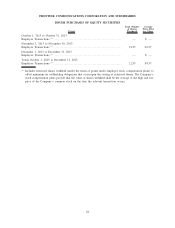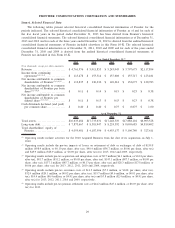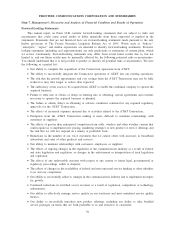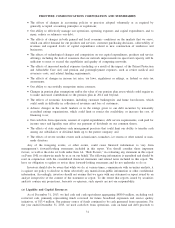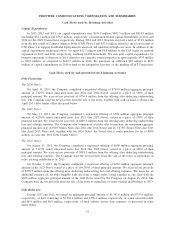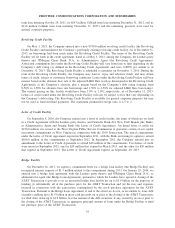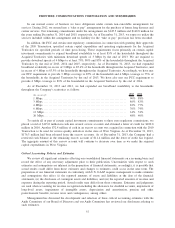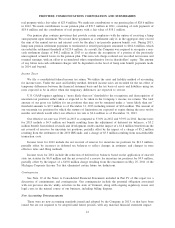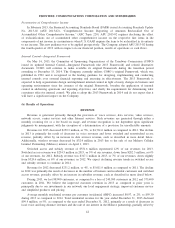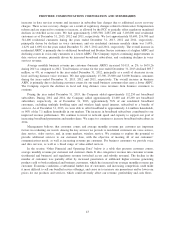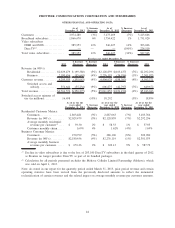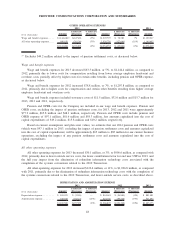Frontier Communications 2013 Annual Report Download - page 39
Download and view the complete annual report
Please find page 39 of the 2013 Frontier Communications annual report below. You can navigate through the pages in the report by either clicking on the pages listed below, or by using the keyword search tool below to find specific information within the annual report.Revenue Recognition
Revenue is recognized when services are provided or when products are delivered to customers. Revenue
that is billed in advance includes: monthly recurring network access services (including data services), special
access services and monthly recurring voice, video and related charges. The unearned portion of these fees is
initially deferred as a component of current liabilities on our consolidated balance sheet and recognized as
revenue over the period that the services are provided. Revenue that is billed in arrears includes: non-recurring
network access services (including data services), switched access services, non-recurring voice and video
services. The earned but unbilled portion of these fees is recognized as revenue in our consolidated statements
of operations and accrued in accounts receivable in the period that the services are provided. Excise taxes are
recognized as a liability when billed. Installation fees and their related direct and incremental costs are initially
deferred and recognized as revenue and expense over the average term of a customer relationship. We
recognize as current period expense the portion of installation costs that exceeds installation fee revenue.
We maintain an allowance for doubtful accounts based on our estimate of our ability to collect accounts
receivable. Our estimates are based on assumptions and other considerations, including payment history,
customer financial performance, carrier billing disputes and aging analysis. Our estimation process includes
general and specific reserves and varies by customer segment. In 2013 and 2012, we had no “critical estimates”
related to bankruptcies of communications companies or any other significant customers.
Asset Impairment
We review long-lived assets to be held and used, including customer lists, and long-lived assets to be
disposed of for impairment at least annually or whenever events or changes in circumstances indicate that the
carrying amount of such assets may not be recoverable. Recoverability of assets to be held and used is
measured by comparing the carrying amount of the asset to the estimated fair value, which is based on the
future undiscounted net cash flows expected to be generated by the asset. Recoverability of assets held for sale
is measured by comparing the carrying amount of the assets to their estimated fair market value. If any assets
are considered to be impaired, the impairment is measured by the amount by which the carrying amount of the
assets exceeds the estimated fair value. Also, we periodically reassess the useful lives of our tangible and
intangible assets to determine whether any changes are required. In 2013 and 2012, we had no “critical
estimates” related to asset impairments.
Intangibles
Our indefinite-lived intangibles consist of goodwill and trade name, which resulted from the purchase of
ILEC properties. We test for impairment of these assets annually, or more frequently, as circumstances warrant.
We test for goodwill impairment at the “operating segment” level, as that term is defined in U.S. GAAP.
Effective with the first quarter of 2013, the Company reorganized into four regional operating segments. The
four operating segments consist of the following regions: Central, East, National and West. Our regional
operating segments are aggregated into one reportable segment since they have similar economic
characteristics. In conjunction with the reorganization of our operating segments during the first quarter of
2013, we reassigned goodwill to our reporting units using a relative fair value allocation approach. This
structure is consistent with how our Chief Operating Decision Makers (Chief Executive Officer, Chief Financial
Officer, President and Chief Operating Officer) review our results on a daily, weekly and monthly basis. After
making the change in our operating segments, we reviewed our goodwill impairment test by comparing the fair
value for each reporting unit to its carrying value. No potential impairment was indicated and no further
analysis was deemed necessary.
Our annual goodwill impairment testing date is December 31. Each of the operating segments is also a
reporting unit. The first step in the goodwill impairment test compares the carrying value of net assets of the
reporting unit to its fair value. The result of this first step indicated that fair value of each reporting unit
exceeded the carrying value of such reporting units. As a result, the second step of the goodwill impairment test
was not required.
38
FRONTIER COMMUNICATIONS CORPORATION AND SUBSIDIARIES


